| Author |
Message |
|
Hendrik De Coster
|
 Posted: Fri 19 Nov, 2010 2:46 pm Post subject: Posted: Fri 19 Nov, 2010 2:46 pm Post subject: |
 |
|
|
the knight on the left is actually saint george;)
|
|
    |
 |
Randall Moffett

|
 Posted: Fri 19 Nov, 2010 2:59 pm Post subject: Posted: Fri 19 Nov, 2010 2:59 pm Post subject: |
 |
|
Some very interesting terms and explanations on a very complicated topic. I think some time I will have to get more familiar with the many medieval German languages as my latin, french, spanish, english and old english are of limited use but it does look truly fascinating.
To be fair Jens, as I posted earlier, I have seen no evidence for unpadded underarmour in the 13th to the mid, maybe 3rd quarter of the 15th really excluding the Hastings MS for mail or plate. To me artwork is not a solid evidence for layers of defence and every time layering is given in text, from Arthur in a 1330s poem to English inventories late in the 100 years war seems to go along with this. The lack of any layering account without the padded or textile layer to this point makes things suspect. At least till the 1420s padded underarmour seems to have been the norm in much of Europe under plate. I know of little evidence that directly indicates aketon/gambesons were anything other than padded at this time and/or not used often in conjunction with plate harnesses. I cannot think of a single textual account that details layers without a gambeson or aketon, even if they are used rather ambiguously between the two or more terms. Even the Hastings MS is not strong evidence as it is general on several accounts so omission should not be used to discount remaining accounts such as Sir John Fastoff or King Charles VII where there is fairly clear evidence of padded garments used in conjunction with plate and mail harnesses.
That said I do not see a great difference between a textile armour that is 'padded' with cotton or multilayered linen layers. They are made to add extra comfort and protection to the wearer, and as Williams has shown they greatly increase the level of protection offered. It seems that many remaining doubtlets have both multilayers and padding. Sure this is not direct evidence but since we have loads of text backing the use of multilayered and padded underarmour I do not think it should be discounted.
In the end I figure it possible, even likely unpadded and/or sturdy doubtlets were used under plate, maybe even mail. To me though discounting the use of such padded and related garments is simply ignoring the many remaining textual and to a degree physical examples. If one cares to wear and unpadded or like garment armour I'd say go ahead, it is feasible and a possible interpretation of the Hastings MS, but to try and ignore the fact there is loads of evidence that padded under armour was a common system of defence, if not the more common for much of the late medieval period in much of Europe is just not accurate.
So while I can agree there likely was unpadded types of under armour I think their prevalence and duration of use is much larger spread and longer than you're giving them credit for.
RPM
|
|
  |
 |
Mark T

|
 Posted: Fri 19 Nov, 2010 3:32 pm Post subject: Posted: Fri 19 Nov, 2010 3:32 pm Post subject: |
 |
|
Blaz, seeing as you've posted a couple of images with just a 'peek' of a garment underneath, here's one more: Saint George and the Dragon by Roger van der Weyden, 1432-1435.
I've included two versions, as they have slightly different colourings; a large version can be found in Edge & Paddock's Arms and armour of the Medieval Knight on page 102.
 Attachment: 64.82 KB Attachment: 64.82 KB
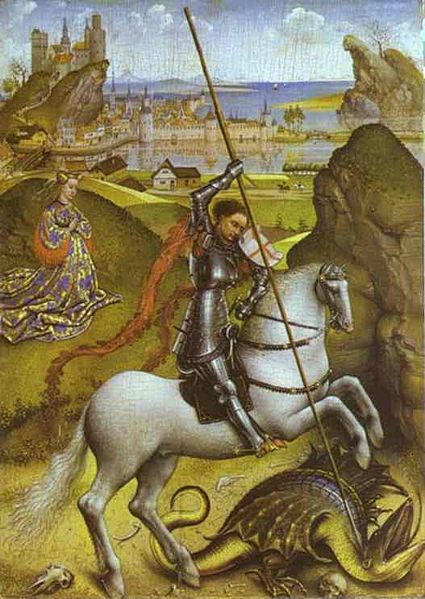
 Attachment: 23.92 KB Attachment: 23.92 KB
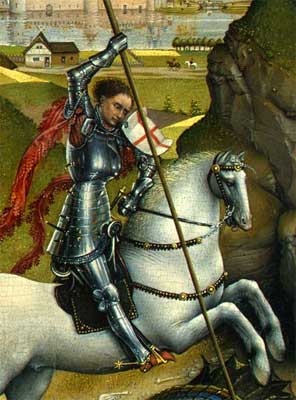
Chief Librarian/Curator, Isaac Leibowitz Librarmoury
Schallern sind sehr sexy!
|
|
  |
 |
Mark T

|
 Posted: Fri 19 Nov, 2010 3:44 pm Post subject: Posted: Fri 19 Nov, 2010 3:44 pm Post subject: |
 |
|
There's also Friedrich Herlin's 'St George and the Dragon', c. 1460. The only image I could find online is small; black and white versions are given in Blair's European armour and Ospreys Armies of medieval Burgundy, but a better colour image is in Edge & Paddock, p. 110.
This painting shows curvatures on the bottom hem of the garment, suggesting quilting/padding. This garment also ends at upper thigh height, rather than waist. If anyone can post a larger version so we can all see the detail, that would be great.
 Attachment: 9.27 KB Attachment: 9.27 KB

Chief Librarian/Curator, Isaac Leibowitz Librarmoury
Schallern sind sehr sexy!
|
|
  |
 |
Blaz Berlec

|
 Posted: Sat 20 Nov, 2010 5:12 am Post subject: Posted: Sat 20 Nov, 2010 5:12 am Post subject: |
 |
|
I know that this is not a primary information about medieval garment, but it nonetheless show us what is available. Which is kind of important to me since I don't intent to sew it myself.
Commercially available arming doublets:
Historic Enterprises, Doublet, Arming, 15th century, $274.95
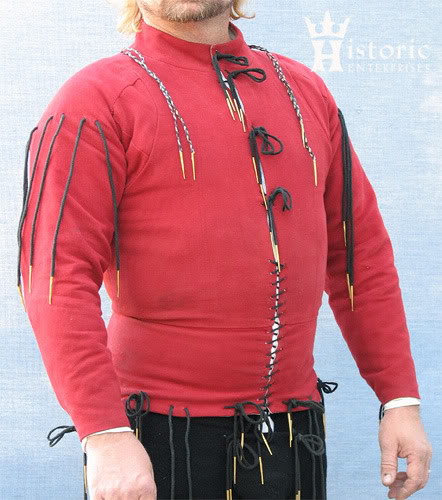 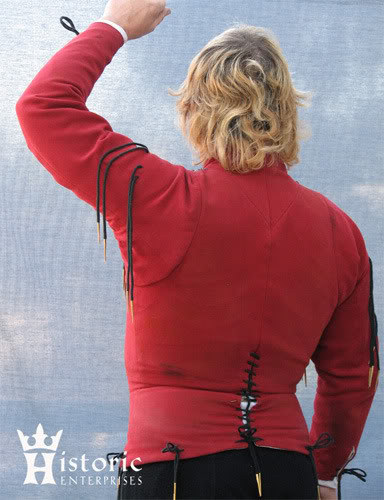
The doublet closes in the center front and at the wrist with points. Spiral lacing at the center front and center back allow for a completely custom fit on the body. A matrix of 18 eyelets over each hip and near the side allow for custom placement of the leg harness. 6 eyelets on the outside of each upper arm allow for custom placement of the arm harness. The arming doublet is reinforced in the peplum, collar, shoulder and upper arm area. Thread eyelets are worked through all layers to prevent tear-throughs.
Lined in linen, outer fabric linen, fustian or cotton.
The Padded Armour Company, 15th century arming doublet
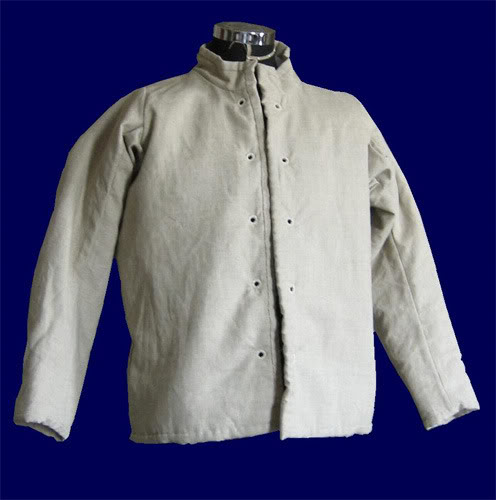 
Off white linen outer, white linen lining. Woollen padding. Fully gusseted at centre back and under arms. Point fastening, with port piece. Point holes to support armour. Hand sewn edging. Point holes are reinforced with hidden metal rings.
The Padded Armour Company, late medieval arming doublet
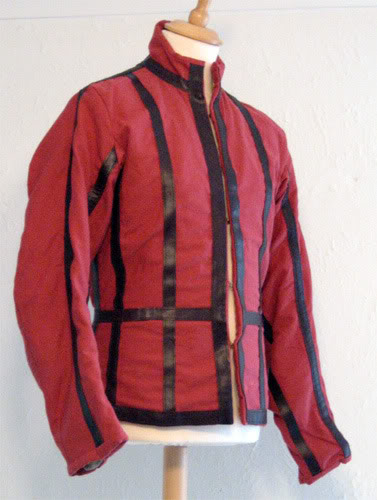 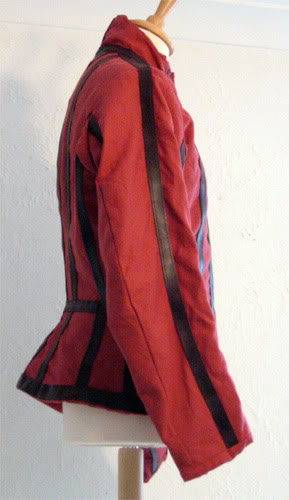
Late medieval arming doublet. Red linen outer, reinforced with brown leather. Woollen layered padding lined in white linen. Fully gusseted. Fastens at front with hand made hooks and eyes.
Medieval Market, Arming doublet, 15th century
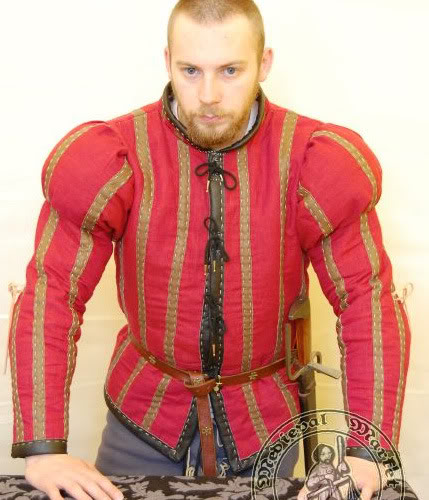 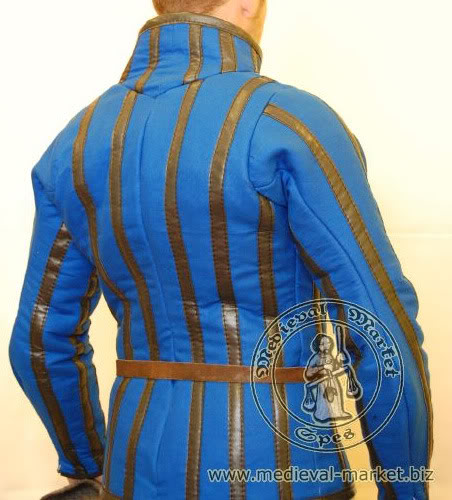
A thin garment, cut in the waist, with leather strips sewn on top. The sleeves are not puffed (can be puffed with a surcharge +10 EUR).
Gambesons were a cheap protection for the fighting men in the Middle Ages, but only the poorest ones used only them as their single armour. For others they were a part of a complete protective armament, providing amortization of the hit and the protection of attritions from the armour. Among padded protective elements we can find: gambesons protecting the trunk and hands, padded gloves, padded coifs and separate hoses. They were sewn from layers of a fabric. In the 13th century gambesons were long and rather badly-fitted to the figure. They were usually put over the head and buttoned only near the neck. Later, with the development of other elements of the armour, gambesons were shorter and better fitted to the body. In the 14th and the 15th centuries they were usually buttoned at the front or laced up.
Linen, hand sewn, 320.00 EUR
Linen, machine sewn, 169.00 EUR
Medieval Market, Arming doublet type 2, 15th century
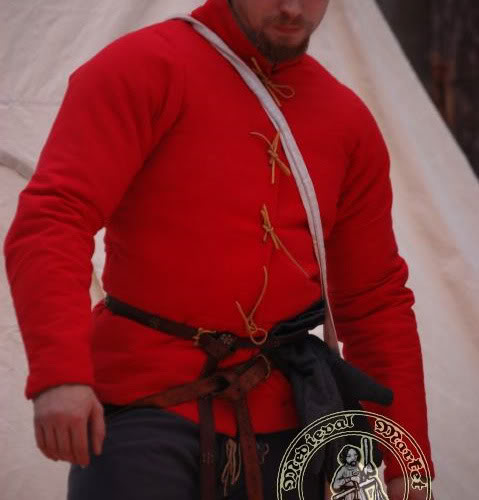 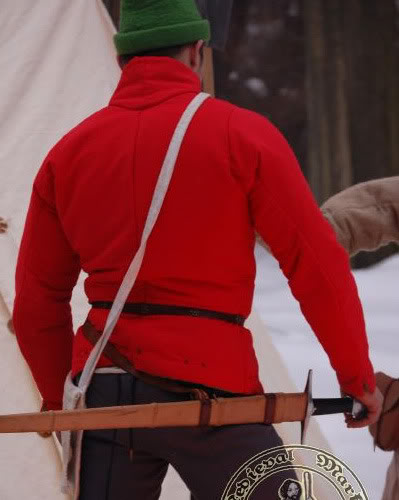
Doublet from the XV century, worn under armour. Doublet is thinly quilted to the lining. There is an option to order the doublet with eyelets for fastening chainmail elements (extra charge).
Linen, hand sewn, 287.00 EUR
Linen, machine sewn, 147.00 EUR
Matuls.pl, 15th century arming doublet - Type 1
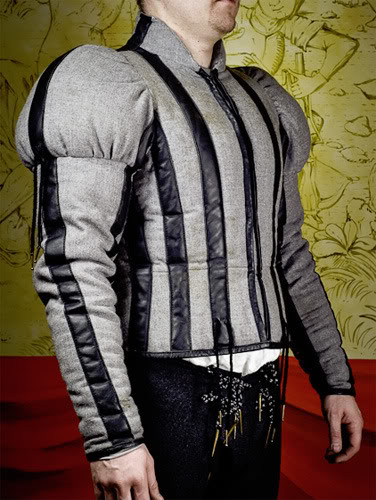
Arming doublet worn as a base garment for armour. Made up of three layers:
Outer layer - wool or linen, reinforced with leather straps
Filling - 100% cotton
Lining - silk or linen
Reconstruction of a 15th century arming doublet with puffs. which has been developed to be practical in battle. The trunk and sleeves are filled with four layers of cotton, the puffs, 16 layers. The lining can be made from pure silk to ensure ease of dressing and undressing. the arming doublet weighs about 2kg and is fastened with five pairs of hooks. By special request it can be fastened with bronze buckles.
Price 180 EUR
Matuls.pl, 15th century arming doublet - Type 2
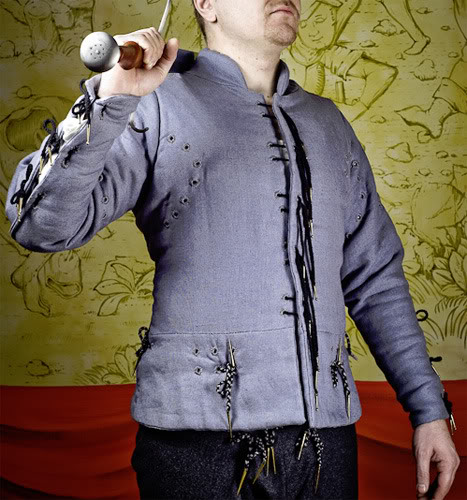
Arming doublet thiner then the model reinforced with leather straps. It can be worn as a base garment for armour.
It has eyelets for attatching armour parts and hose. it has also eyelets for mounting chainmail pieces uder arms.
It is fastened with points. By special request it can be fastened with bronze buckles.
In standard all eyelets are handmade.
Price 150 EUR
Matuls.pl, 15th century arming doublet - Type 3
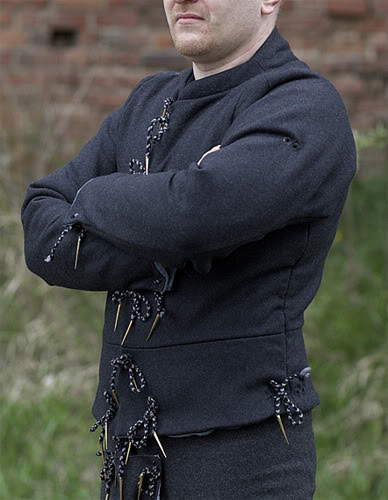 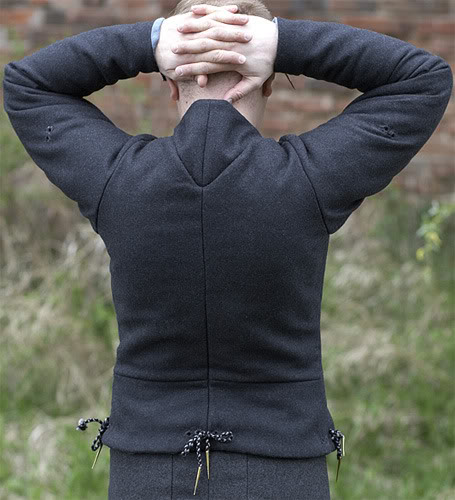
Arming doublet worn as a base garment for armour. Made up of three layers:
Outer layer - wool
Filling - 100% cotton
Lining - linen
Reconstruction of a 15th century arming doublet which has been developed to be practical in battle. The trunk and sleeves are filled with four layers of cotton. The arming doublet weighs about 2kg and is fastened with five pairs of eyelets. By special request it can be fastened with bronze buckles.
Price 165 EUR
aRDi couture, Arming doublet, circa 1460, replica
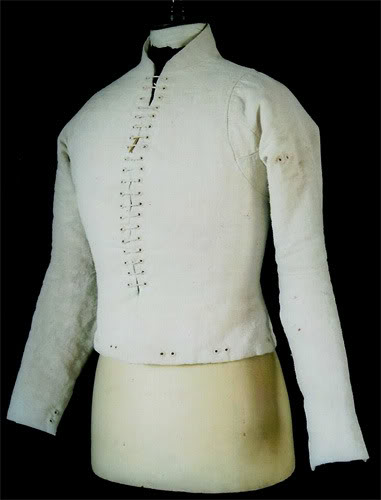
Protective military garment, seven layers: cotton stuffed, overpicked between two layers of linen ( x 2 ). Overlayed with final exterior layer, also of linen. Similar garment appears in a civil role, but from one to four layers.
Entirely sewn by hand- from 1100 euros.
Civilian version from 400 euros.
Extant 15th Century German Gothic Armour
Extant 15th century Milanese armour
Arming doublet of the 15th century
|
|
   |
 |
Mark T

|
 Posted: Sat 20 Nov, 2010 1:42 pm Post subject: Posted: Sat 20 Nov, 2010 1:42 pm Post subject: |
 |
|
Hi Blaz,
There's also Revival Clothing's Agincourt Arming Cotte (http://www.revivalclothing.com/agincourtarmingcotte.aspx):
| Quote: | Based on historical patterns and research
Designed in conjunction with Doug Strong of the Armour Research Society
Engineered for ease of motion and designed to support your harness very comfortably
Made of 100% heavy linen outer and lining
Arming Points attatched for ready-to-wear pointing of your armour
Design laces closed in front and at the sleeve, past the elbow for custom fit
'Port-piece' (a period term for the front placket) in front provides finished look and complete coverage- which is also a period solution!
Available Colors: Black only
Available in 4 sizes
Price - Reg. US$249.95 |
 Attachment: 41.78 KB Attachment: 41.78 KB
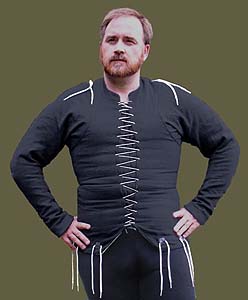
 Attachment: 37.48 KB Attachment: 37.48 KB
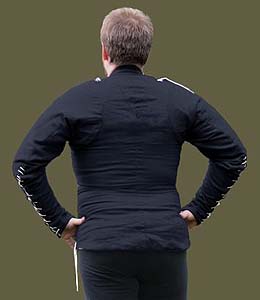
Chief Librarian/Curator, Isaac Leibowitz Librarmoury
Schallern sind sehr sexy!
|
|
  |
 |
|
Jens Boerner
Location: Erlangen, Germany Joined: 10 Jan 2008
Posts: 62
|
 Posted: Sun 21 Nov, 2010 4:11 am Post subject: Posted: Sun 21 Nov, 2010 4:11 am Post subject: |
 |
|
Guys, honestly, I don't think reconstructions themself are of very much value. Most of those just postet seem to be base more on the modern practical issues than on historical evidences.
| Randall Moffett wrote: |
To be fair Jens, as I posted earlier, I have seen no evidence for unpadded underarmour in the 13th to the mid, maybe 3rd quarter of the 15th really excluding the Hastings MS for mail or plate. |
We are turning in circles. It does not make sense to try to find evidences _against_ something, first you have to find some _for_ them. But nevertheless, there are enough images, texts and effigies showing no trace for a textile armour underneath the other armour. for the 13th century, the all-famous Majekowski-bible is one of the most well-known. mid-to-late14th century: limburg chronicles mentioning the men-at-arms wearing parts of maille on their doublets. No mentioning of padded armour, but instead strange terms like the "lendenier" being something worn just at the hip (not the one holding up the leg armour, like in earlier instances). It is simply _not_ that all easy "padded garment goes underneath armour".
If you know of clearly identifyable(!) _military_(!!) quilted garments in the late 14th century, worn underneath maille or plate- please show me examples. Same for the first quarter of the 15ht century. Again, the lubeck and stendal types are no doublets. We have lots of examples showing such garments- but in most cases without a backplate, and in lots of them over a maille short, if worn.
| Quote: |
To me artwork is not a solid evidence for layers of defence and every time layering is given in text, from Arthur in a 1330s poem to English inventories late in the 100 years war seems to go along with this. The lack of any layering account without the padded or textile layer to this point makes things suspect. At least till the 1420s padded underarmour seems to have been the norm in much of Europe under plate. I know of little evidence that directly indicates aketon/gambesons were anything other than padded at this time and/or not used often in conjunction with plate harnesses. I cannot think of a single textual account that details layers without a gambeson or aketon, even if they are used rather ambiguously between the two or more terms. Even the Hastings MS is not strong evidence as it is general on several accounts so omission should not be used to discount remaining accounts such as Sir John Fastoff or King Charles VII where there is fairly clear evidence of padded garments used in conjunction with plate and mail harnesses.
|
Can you please quote those both? I don't know them.
The problem is, I cannot see a generality there. An evidence for an aketon worn 1420 in England or France is nothing more: an evidence for an aketon worn in 1420 in England and France. No evidence fro 1400, not for 1380, not for Germany, or italy.
| Quote: |
That said I do not see a great difference between a textile armour that is 'padded' with cotton or multilayered linen layers. They are made to add extra comfort and protection to the wearer, and as Williams has shown they greatly increase the level of protection offered. It seems that many remaining doubtlets have both multilayers and padding. Sure this is not direct evidence but since we have loads of text backing the use of multilayered and padded underarmour I do not think it should be discounted. |
Do we have loads? I know of only one often-citated from the 15th century discribing textiel armour made from multiple layers of linnen (and leather in between). If you know more, please quote them  The surviving all feature cotton wool between _few_ layers- too few to make a difference, but in practical construction, the multi-layering saves the cooton wool from being pulled outwards during stitching. Which would be nothing you aim for for a textile armour covered with silk satin damask The surviving all feature cotton wool between _few_ layers- too few to make a difference, but in practical construction, the multi-layering saves the cooton wool from being pulled outwards during stitching. Which would be nothing you aim for for a textile armour covered with silk satin damask  And I cannot mention it often enough: not everything is a doublet. And I cannot mention it often enough: not everything is a doublet.
| Quote: |
In the end I figure it possible, even likely unpadded and/or sturdy doubtlets were used under plate, maybe even mail. To me though discounting the use of such padded and related garments is simply ignoring the many remaining textual and to a degree physical examples. If one cares to wear and unpadded or like garment armour I'd say go ahead, it is feasible and a possible interpretation of the Hastings MS, but to try and ignore the fact there is loads of evidence that padded under armour was a common system of defence, if not the more common for much of the late medieval period in much of Europe is just not accurate. |
Well, nobody can deny you having your opinion, but again, you cannot make a generalization from local examples. The hastings MS is england, around mid-15th. That does that tell me about german armour in the 1470s? Nothing.
What does wearing an aketon underneath a 1340s armour consisting of maille and coat of plates tell be about an northern italian men-at-armes wearing a breat plate, some maille parts and a jupon? Nothing. That he is wearing an aketon in addtion is pure speculation, and does not even make much sense. So I'm not talking about ignoriing existing ones, but being more precise.
|
|
    |
 |
|
Till J. Lodemann
|
 Posted: Sun 21 Nov, 2010 6:25 am Post subject: Posted: Sun 21 Nov, 2010 6:25 am Post subject: |
 |
|
Wow, loads of usefull information since my last visit here!
But still though your contributed much valuable information to the topic, Jens, you fail to prove your thesis on padded/quilted underarmour until the 1450ies
Nearly all extant medieval artwork, your main evidence here, is not appropriate to deduce any answer to the question of what under armour would be like, they simply do not show what is beneath the outer, visible layer. Do you have any positive evidence for unpadded/quilted underarmour prior to the 1450ies?
Randall has stated good evidence for padded/quilted underarmour, again.
Ah and why are there so few garments which were worn under armour extant today?
Apart from the Stendal/lübeck examples (which were quilted, not plain), there are non. And why would one keep such things anyway? After it has served it's purpose, it is stained and doesn't smell particulary well, it has no symbolical value and it is not very precious.
(The Black Prince and Charles the VI jupons were kept because of the significance of their royal wearers)
Noone here argues for thick 30 layered jacks under late gothic harnesses. And it's clear that padded armour is a delicate topic with no easy answers.
Nontheless, the stated evidence for the use of padded underarmour is heavier then the arguments against it. A simple task for Ochams razor, isn't it?
What remains is your opinion. As you rightly say, everyone as a right to have one.
|
|
  |
 |
Thomas R.

|
 Posted: Sun 21 Nov, 2010 8:28 am Post subject: Posted: Sun 21 Nov, 2010 8:28 am Post subject: |
 |
|
Perhaps you are interested in a quotation from Katrin Kania's "Kleidung im Mittelater (Clothing of the Middleages), 2010. It's a doctoral thesis with lots of information on existant original clothing. I did a short translation for your convenience.
She writes on page 103:
"More often are textual passages, which mention protective clothing with padding. In the Limburg Chronicles of Tileman Elhen von Wolfenhagen, which covers the time span from 1346 until 1398, protection of the legs is mentioned in the year 1350 like this:
<They wore clothings for the legs, which were leather tubes, made like the leathers for the arms of padded surcots (Waffenröcke), and in combination with iron kneecaps.>
For 1371 the same chronicle contains a clue to quilted clothings in lines:
<And it was this time, the westphalian Lentners were worn. These were made in a way, that knights, squires and soldiers wore them. They began at breastheight, were laced together very tight on the back and came down as far as the tights were broad. They were tightly quilted, almost as thick as a finger.>"
Furthermore she mentions french sources from 1323, which state, that a padded clothing shall not contain more than 3 pounds of wad. An other source from 1380 says, that "Pourpointiers" - padded garment makers - shall not use less than 1,5 to 2 pounds of wad for their garments.
I think it's clear that there were padded or quilted arming garments in use in the 14th century.
Regards,
Thomas
http://maerenundlobebaeren.tumblr.com/
|
|
   |
 |
|
Bertus Brokamp
Location: Alphen aan den Rijn, Netherlands Joined: 20 Jan 2010
Posts: 5
|
 Posted: Sun 21 Nov, 2010 12:03 pm Post subject: Posted: Sun 21 Nov, 2010 12:03 pm Post subject: |
 |
|
| Blaz Berlec wrote: | Excellent! The garment of the left knight (that has no backplate) is almost the same as on the Jens Boerners' photo from the first page. But it is even more interesting that kneeling figure which has complete cuirass has similar garment underneath, and it ends with decorative fringes that are also on Lübeck examples! I wonder what is the dating of the monument - it looks almost as if left and kneeling figure are from around 1440 - 1450, and the right one from a later date.
ca. 1470-1475 - 'Engelbrecht I (+1442) and Jan IV (+1475) van Nassau, Lords of Breda and the Lek', Grote Kerk, Breda, province of North Brabant, Holland
Photo by By roelipilami, Roel Renmans: http://www.flickr.com/photos/roelipilami/1557...otostream/ |
The most recent study on the effigy dates it to the very early 16th c. based on the style of the whole monument. But I agree that the sculptor made the armour in the fashion as both deceased father and son could have worn in their own lifetime.
Bertus Brokamp
|
|
  |
 |
Randall Moffett

|
 Posted: Sun 21 Nov, 2010 3:23 pm Post subject: Posted: Sun 21 Nov, 2010 3:23 pm Post subject: |
 |
|
Jens,
To me, as I said earlier, artwork is just to unreliable for this type of research and evidence when you have fairly clear text available. The Mac Bible is up to anyones guess as it has at least two scenes that show what could be quilted padding worn under mail, where as one popular one showing a man putting mail on without. Not much support either way there. The issue is unless you find evidence that directly states one wore the armour without padding then why should anyone disregard the large numbers that come up in texts that include men wearing it? To me this is the main issue with these arguments. peripheral estimates and evidence should not trump the fact we have from the late 12th to the early 16th evidence for padded and textile armour being worn under plate and mail. To me the first instance of real hard textual evidence for unpadded under armour is the Hastings MS and I'd not bet my farm on that.
I will give a few quick ones I can think of from the late 14th and into the middle of the 15th as this seems to be where the main issue lies. All include evidence of textile armour under plate.
Bertrand's Guesclin Chronicle- Post 1380
Enguarrand de Monstrelet, In his Chronicle, 1420s-1430s
Warryn's Chronicle 1450s
Charles the Bold's Ordinances, 1460-1470
York Archdz. Probate Records (in the Archbiz. Library with a translated copy at the Civic library and University there). late 14th into 16th.
These are the only ones I could think of off the top of my head but for some time I was making a list of accounts that were textile and some day I plan on writing a fairly detailed paper on it. Once I get unpacked and find my notes from my PhD that is.
RPM
|
|
  |
 |
|
Jens Boerner
Location: Erlangen, Germany Joined: 10 Jan 2008
Posts: 62
|
 Posted: Mon 22 Nov, 2010 6:04 am Post subject: Posted: Mon 22 Nov, 2010 6:04 am Post subject: |
 |
|
| Thomas R. wrote: |
<They wore clothings for the legs, which were leather tubes, made like the leathers for the arms of padded surcots (Waffenröcke), and in combination with iron kneecaps.>
|
Maybe I remember wrong, but I cannot remember any mention of leather in that case. But I'll check that. However, the chronicles are anything but very precise.
| Quote: |
<And it was this time, the westphalian Lentners were worn. These were made in a way, that knights, squires and soldiers wore them. They began at breastheight, were laced together very tight on the back and came down as far as the tights were broad. They were tightly quilted, almost as thick as a finger.>" |
Yeah. Those might haben been(!) jupons. We don't know how they wore them.
| Quote: |
Furthermore she mentions french sources from 1323, which state, that a padded clothing shall not contain more than 3 pounds of wad. An other source from 1380 says, that "Pourpointiers" - padded garment makers - shall not use less than 1,5 to 2 pounds of wad for their garments. |
I Know both sources. For the early 14th century, no question. However the Pourpointiers made civil garments (also) and were always in discussion with the doubletmakers. No evidence for a military garment worn underneath.
| Quote: |
I think it's clear that there were padded or quilted arming garments in use in the 14th century.
|
No- it is clear that there were quilted garments worn underneath the other armour in the early 14th century (as said I never doubted that- I've got a list of evidences on our website, I linked that one page before). And we know there were quilted garments in the late 14th century- which is also undoubted, there are surving ones, both civil and military. However, that does not tell us if there was such a thing as a quilted "arming doublet".
| Till J. Lodemann wrote: | Wow, loads of usefull information since my last visit here!
But still though your contributed much valuable information to the topic, Jens, you fail to prove your thesis on padded/quilted underarmour until the 1450ies
Nearly all extant medieval artwork, your main evidence here, is not appropriate to deduce any answer to the question of what under armour would be like, they simply do not show what is beneath the outer, visible layer. Do you have any positive evidence for unpadded/quilted underarmour prior to the 1450ies? |
But I've already mentioned those? If somebody wears a cotte and pulls a maille shirt over it, I would say, this is quite clear 
Again I can only emphasize: the generalisation "under maille and armour prior 1450 goes padded/quilted textile clothing" is wrong- we lack clear evidences how the garment worn underneath late 14th century armour was constructed, and we have several images/text mentionings of the lacking of any quilted textile when the armour is put on. And, after all, you don't really need it from the late 14th on. A simple, sturdy garment with perhaps laces stichted to it is enough.
I simply want to break up that general legend of the "gambeson underneath armour".
And I think it is very very important to make a difference between the stendal and lubeck garments, and what you call an "aketon" or an "arming doublet"- simply because we have several statues, images etc. showing that they were worn diffenrently. Over maille, with breastplate tied on, without backplate and/or plate skirt. They do have no sleeves, you cannot tie your arm harness to it. No traces here. They have laces for possibly the leg armour.
You still need something worn underneath it. Possibly a doublet in that time frame.
And we have no clue how that was constructed.
Up to now, I see no evidence for "padding" etc. here.
|
|
    |
 |
Blaz Berlec

|
 Posted: Sat 04 Dec, 2010 1:06 am Post subject: Posted: Sat 04 Dec, 2010 1:06 am Post subject: |
 |
|
I've found a really interesting Italian sculptures (after 1483) on Arms and Armour Forum, photos were made by Oleg Naumov (under ARMOUR, ARMS, FIREARMS AND MUCH MUCH MORE > Arms and Armour Iconography > The Statues Of The Pages The Shield Bearers - but you have to be registered to see it).
Text by Oleg Naumov:
| Quote: | | The statues of the Pages the Shield bearers, attributed to the workshop of Antonio Rizzo. These statues were installed in the Church of Santa Maria dei Servi in Venice and used to be a part of Giovanni Emo the Doge of Venice tomb. Sculptor made the very detailed arming doublets with the arming points and attached pieces of the chain mail. Both pages wear the liveries with coat of arms presumably belonged to Giovanni Emo or Emo family. There are two letters on the first quarter of livery’s coat of arms. The second letter is obviously E I believe for Emo and first one is unreadable for me. Probably this is I or J |
Thumbnails, click for bigger pictures.
 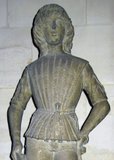  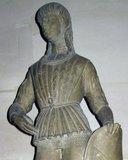 
I really don't understand the layering on this one (actually, these two, one has shield in left hand and one in right. Other than that they are nearly identical  ). On top it has pleated "giornea". Under it looks like a very highly cut doublet without arms, it seems too high to hold hose with the laces on waist, could they be for mail skirt? If it is a skirt, and not a hauberk with short or no sleeves, there are several rows of mail visible around collar of the giornea. Hose only comes up to the hips, never to the (high) waist in 15th century. Lower edge of this doublet has holes beside the edge, is this where the mail skirt is attached directly to it? Sleeves are clearly separate, and between this doublet and sleeves looks like a garment underneath has vertical rows of stitching (more evident on a figure that has shield in his right hand). Sleeves are similar to the typical Italian doublet of 15th century (farsetto), although I have never seen such a doublet with separate sleeves. On shoulders are very wide points (laces), it looks like two pairs from side view. Sleeves are laced under the forearm, and it looks there is a shirt underneath. ). On top it has pleated "giornea". Under it looks like a very highly cut doublet without arms, it seems too high to hold hose with the laces on waist, could they be for mail skirt? If it is a skirt, and not a hauberk with short or no sleeves, there are several rows of mail visible around collar of the giornea. Hose only comes up to the hips, never to the (high) waist in 15th century. Lower edge of this doublet has holes beside the edge, is this where the mail skirt is attached directly to it? Sleeves are clearly separate, and between this doublet and sleeves looks like a garment underneath has vertical rows of stitching (more evident on a figure that has shield in his right hand). Sleeves are similar to the typical Italian doublet of 15th century (farsetto), although I have never seen such a doublet with separate sleeves. On shoulders are very wide points (laces), it looks like two pairs from side view. Sleeves are laced under the forearm, and it looks there is a shirt underneath.
Of course sleeves could be part of doublet with vertical stitching, and there is an extra short doublet on top that holds mail skirt, and then giornea on top.
What do you think?
(and by the way, Emo died in 1483) 
Extant 15th Century German Gothic Armour
Extant 15th century Milanese armour
Arming doublet of the 15th century
|
|
   |
 |
|
Zac Evans
|
 Posted: Sat 04 Dec, 2010 3:03 am Post subject: Posted: Sat 04 Dec, 2010 3:03 am Post subject: |
 |
|
I think people need to take a bit of time out and actually look at what Jens is saying, rather than what they think he's saying. What he's saying, if I'm correct, is that we don't need to say that padding was ALWAYS worn under maille. He's given some examples of where there seem to be people wearing maille without padding.
What he is not saying, i think, is that padding was NEVER worn beneath maille.
Saying that the Mac Bible shows both forms is actually helping his point, rather than against it. Saying we should discount it because it's art rather than writing means we should discount most of this thread, and throw out most of the reproductions anyone has made of textile clothing of the middle ages.
As for the topic in general, I'm enjoying it. I am going to be reconstructing an "arming doublet" soon to go under a late 15th century harness. I may try and document it in the same way Jens does for all of his garments. If I do, then I'll post it up here.
|
|
  |
 |
|
Kel Rekuta
|
 Posted: Sat 15 Jan, 2011 10:59 am Post subject: Posted: Sat 15 Jan, 2011 10:59 am Post subject: |
 |
|
Unfortunately this thread has devolved into nit picking about late 15thC designs.  I'd like to swing back to the original topic, which Blaz was kind enough to kick off. I'd like to swing back to the original topic, which Blaz was kind enough to kick off.
It seems there is a big gap in available Italian men's garments between the late 14thC and mid 15thC. The farsetto of Malatesta Pandolfino (c1437) falls into that range but no one seems to make a version of it in North America. A couple Italian vendors make similar garments, as well as a couple Polish vendors.
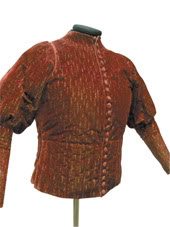
Historic Enterprises makes a late 15thC arming doublet and Revival Clothing has a very late 14thC arming doublet which they've decided to call the Agincourt style. As well as these might work, they don't look anything like the above mentioned garment, so won't do as stand-ins. :sad:
Like many other people, I need a working garment that suits the period of my harness. I thought I'd cast it out to there to see if anyone makes one. I have nothing against the vendors previously listed but none of them are offering the garment I need. I'm sure I'm not the only one looking for men's garments from the period 1410-1430. Suggestions? 
|
|
   |
 |
|
Hendrik De Coster
|
 Posted: Sat 15 Jan, 2011 11:38 am Post subject: Posted: Sat 15 Jan, 2011 11:38 am Post subject: |
 |
|
|
are you sure the last garment is an arming doublet? i can't see any eyelets for points on the arms. A great source for information about the arming doublet is the paper written by Tobias Capwell, a depiction of an italian arming doublet c1435-1445
|
|
    |
 |
|
Kel Rekuta
|
 Posted: Sat 15 Jan, 2011 12:24 pm Post subject: Posted: Sat 15 Jan, 2011 12:24 pm Post subject: |
 |
|
Hendrik,
No, I don't think the Pandolfino farsetto is an arming garment. I believe it represents the fashion popular in northern Italy, possibly between 1420 to 1430, maybe a bit later. It doesn't have the puffy chest seen earlier nor the mushroom shoulders that became popular later. I am persuaded by my reading that martial and civilian garment styles are inextricably linked. I see no reason this style of garment could not be constructed of sturdier materials for use in arming.
Do you think my opinion is flawed? 
BTW, Toby's article is very helpful but doesn't provide a clear example of the farsetto in this context. The Rex Siphax image is maddeningly limited for the farsetto / doublet. Nice giornea though!
|
|
   |
 |
|
Hendrik De Coster
|
 Posted: Sat 15 Jan, 2011 3:31 pm Post subject: Posted: Sat 15 Jan, 2011 3:31 pm Post subject: |
 |
|
oh no, kel, for a minute i was just thinking you meant this was an arming doublet, my bad! when you look carefully at the king syphax drawing you'll notice the upper sleeve is a bit looser then the lower half what could indicate a similar garmet as the one you posted. on page 17 of the paper there is also shown a similar garment as well as on page 18
edit* for those who don't have access to the article here's the drawing we're talking about:

and:

although it's not that clear in the picture the valet arming up the man at arms in the center is wearing the same type of garment. although it's not certain he's wearing an arming garment
oh and kel, medieval designs sells a doublet like that;
http://www.medievaldesign.com/eng-prodotti-uomo.asp?page=2 &order=id &form_chiave=29&tipo=
although i'm not sure buttons are study enough. if you've got some experience with needle and thread could easily turn this garmet into an arming doublet if you wanted to. all it would need are some eyelets in the shoulder for the pauldrons, tactfully placed eyelets for the upper canon and some extra eyelets to tie the cuisses to! 
|
|
    |
 |
Blaz Berlec

|
 Posted: Sun 16 Jan, 2011 4:37 am Post subject: Posted: Sun 16 Jan, 2011 4:37 am Post subject: |
 |
|
Do you mean this doublet?

Nobleman doublet
Century - Sources: A close fitting jacket popular during the 15th century. This doublet is seen in the Benozzo Gozzoli "Cavalcata dei Magi"
Materials: Wool, velvet or fustian with silk damasque sleeves - lined in silk
Notes: No exterior machine stitching visible. Hand stitching available on request.
Color choice subject to availability. Mail us for current stock
Doublet with puffed upper sleeve, tight lower sleeve
€ 299.00 with 30 cloth or tin buttons
I would not use such a doublet for an arming garment. I have a Medieval Design doublet (Laces fastening doublet), and is perfect as a civil garment. But I think it isn't sturdy enough for an arming doublet, even if you don't want any padding. Materials are thin (but you still cook under the summer sun), stitches are too weak for anything used in combat - one strong tug on a sleeve and I'm sure something would tear.
I'm not trying to say that Medieval Design isn't OK - my whole civil outfit now is more or less from them, and almost everybody from my group orders from Medieval Design. They are not cheap, but after a while you realise it is worth it - clothes fit properly, are well made and last much longer than other stuff. But arming garments are something different, I'm afraid.
I think it would be worth asking Luciano from Medieval Design if he is prepared to make an arming doublet in the style of Pandolfino farsetto, if that is what you want. They are making one of a kind pieces all the time, and usually they aren't much more expensive than their normal line. Stronger fabric, a bit more padding perhaps, stronger stitches, and it would be perfect.
Extant 15th Century German Gothic Armour
Extant 15th century Milanese armour
Arming doublet of the 15th century
|
|
   |
 |
|
Hendrik De Coster
|
 Posted: Sun 16 Jan, 2011 5:11 am Post subject: Posted: Sun 16 Jan, 2011 5:11 am Post subject: |
 |
|
using stronger fabric etc was offcourse what i ment, but i though kel just wanted to find a modern tailor who made this type of garment. 
|
|
    |
 |
|
|
You cannot post new topics in this forum
You cannot reply to topics in this forum
You cannot edit your posts in this forum
You cannot delete your posts in this forum
You cannot vote in polls in this forum
You cannot attach files in this forum
You can download files in this forum
|
All contents © Copyright 2003-2024 myArmoury.com — All rights reserved
Discussion forums powered by phpBB © The phpBB Group
Switch to the Basic Low-bandwidth Version of the forum
|

